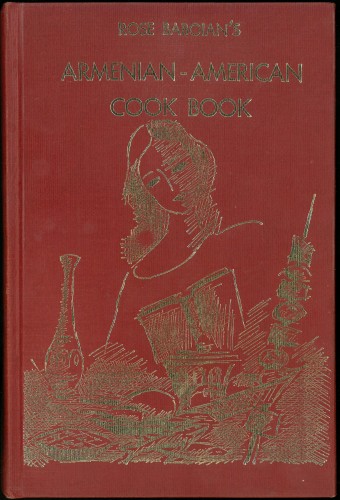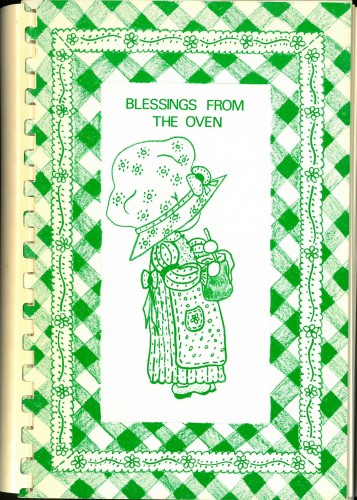The Janice Bluestein Longone Culinary Archive (JBLCA) at the University of Michigan Special Collections Library seeks to document American culinary history, defined broadly to include both influences upon American foodways and the influence of American culinary practices elsewhere. Two of JBLCA’s particular foci are charity cookbooks and cookbooks by immigrants or featuring the cuisine of groups immigrating to the U.S. Although not yet cataloged, the recent acquisition of a small cookbook collection formerly belonging to Colonel Karnig “Carl” Mahakian (1926-2015) contributes to both of these strengths.
Mahakian was born in 1926 in San Francisco, California to Armenian parents who had fled genocide in Turkey. He served in the United States Marine Corps in WWII, the Korean War, and the Vietnam War, and later worked in the film industry. He is particularly notable for his work as assistant film editor for The Manchurian Candidate (1962) and as post-production coordinator on The Brady Bunch from 1969-1974.
Mahakian’s collection consists of 39 cookbooks featuring Armenian, Turkish, and Near Eastern cuisine, dating principally from the 1950s-1990s. Most are written in English and are often directed not only (or even primarily) to members of the Armenian and Turkish immigrant communities themselves, but to a broad audience of American home cooks. For this reason, many authors make a point of offering simplified recipes and reassuring the reader that the dishes will not be too difficult to prepare. Some authors also strive to provide a certain amount of cultural context and explanation in addition to the recipes themselves.
In the preface of Armenian-American Cookbook (1964), Rose Baboian states that her “tested recipes and simplified directions” will be helpful to “those who have never tried Armenian cooking,” and explains that the reason readers see many different recipes with very similar names is that “there are many different kinds of pilaffs, kebabs, sarmas (patats), dolmas (letzadz), lahmejouns, and kuftes.” Baboian places the recipes within her own biographical context, noting that most are from Aintab, Turkey (her birthplace), but that recipes are also included from Aleppo, Syria (where she graduated from the American High School for Girls), as well as a handful of other places including Watertown, MA (her home city in the U.S.).
In the case of a handful of recipes, such as Hadik (whole wheat desssert), Baboian shares personal recollections and culinary traditions. The preparation of bulgur by boiling, sun-drying, and grinding wheat was a social endeavour during her childhood in Turkey, and one that was much anticipated by engaged couples. Because the young woman was often invited to stay at her fiancé's home for several days during the bulgur-making, these events offered a rare opportunity for future spouses to get to know each other. Hadik refers to the interim form of boiled whole wheat. When cooked into a thick, sweet mixture, it was often served at women's celebrations, such as the party marking a baby's first tooth.

Rose Baboian, Armenian-American Cook Book. (Watertown, MA: Rose Baboian, 1964).
Taking another approach, Rachel Hogrogian’s The Armenian Cookbook (1971) includes no preface and virtually no narrative prose. However, it does offer a seven page glossary where the novice can learn that adjeh is “a parsley omelet usually served as an Easter appetizer,” bastegh is “grape juice and cornstarch dried on a flat surface (sometimes referred to as shoeleather)," and manti consists of “meat-filled pastry boats baked with broth and served with madzoon,” which in turn is “the Armenian name for yoghurt.” It also includes the names and addresses of stores offering specialty ingredients, such as the Syrian Grocery Importing Company in Boston, MA or Bezjian’s Grocery in Los Angeles, and several sample menus to help guide the reader to appropriate groupings of dishes. Suggested breakfasts include melon, cheese & olives, Soudjookh (Armenian sausage, highly spiced) and eggs with coffee or tea; or alternatively orange juice, bastegh and eggs, Bishi (pancakes, Armenian-style), and coffee or tea. Despite its unfamiliar vocabulary, The Armenian Cookbook is made inviting by the casual, playful style of illustrations by Nonny Hogrogian, daughter of the author and winner of the 1966 Caldecott Medal for Always Room for One More.

Rachel Hogrogian, The Armenian Cookbook. (New York: Atheneum, 1971).
The charity cookbooks included in Mahakian’s collection offer another avenue into Armenian cooking and into the communities striving to maintain their culinary traditions in America. Some have an implied or explicit goal of educating the next generation of Armenian-Americans. Treasured Armenian Recipes (1949) by the Detroit Women’s Chapter of the Armenian General Benevolent Union, Inc. offers this declaration:
The travails of Armenia are sacred memories. More than that they are a heritage for all humanity, a brave and inspiring page out of the book of history. This is not a proud insular assertion. This is said in all humility. Our young folk should be aware of their roots. They should be able to tie the present with the past. This knowledge we believe will make them better Americans.
Perhaps because of this mission, Treasured Armenian Recipes does not shy away from complex dishes. The Desserts chapter begins with a list of 12 tips for preparing sheet dough, followed by two further pages of dense text giving detailed instructions on “How to Make Sheet Dough for Paklava” and the directions for making “Paklava” itself (paklava being a common Armenian spelling for the dish more widely known in the U.S. as baklava).

Treasured Armenian Recipes (Detroit, MI: The Detroit Women’s Chapter of the Armenian General Benevolent Union, Inc, 1949).
At the same time, other charity cookbooks provide a window into the ways that each generation of Armenian-Americans adapted old dishes and adopted new ones. Blessings from the Oven [circa 1976?], compiled by the Junior Women of the United Armenian Congregational Church in Hollywood, CA, includes not only recipes for "Shish Kabab," "Lahmajoon" (flatbread topped with a ground lamb mixture), and "Madzoun" (home-made yogurt), but also an array of jello molds and casseroles. And in Party Cookery (1977) by the Detroit Armenian General Benevolent Union Women’s Metro Chapter, “Syrian Eggplant Dip/Baba Ghanouj” appears on the same page as “Chinese Egg Rolls,” and “Taboulee” is followed shortly after by “Cocktail Reubens” and “Drunken Hot Dogs.”

Dale Narwitz, ed., Blessings from the Oven (n.p.: Junior Women of the United Armenian Congregational Church, [circa 1976]).

Party Cookery (Southfield, Michigan: Detroit Armenian General Benevolent Union Women’s Metro Chapter, 1977).
Once cataloged, the cookbooks collected by Colonel Karnig “Carl” Mahakian will be available for searching in Mirlyn and accessible in the Special Collections Reading Room. For access prior to cataloging, please contact curator Juli McLoone.